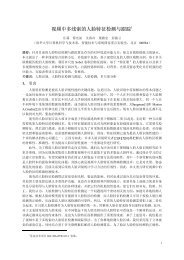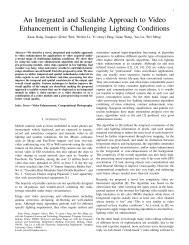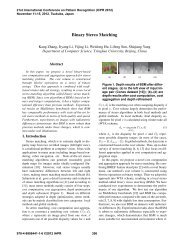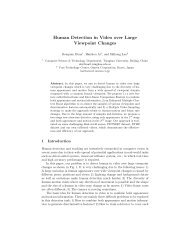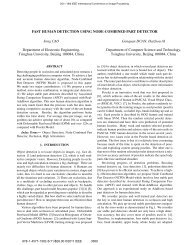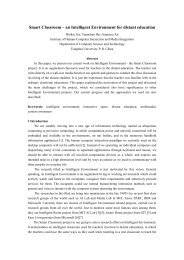An Efficient and Integrated Algorithm for Video Enhancement in ...
An Efficient and Integrated Algorithm for Video Enhancement in ...
An Efficient and Integrated Algorithm for Video Enhancement in ...
You also want an ePaper? Increase the reach of your titles
YUMPU automatically turns print PDFs into web optimized ePapers that Google loves.
4<br />
Fig. 6. Examples of process<strong>in</strong>g steps of low light<strong>in</strong>g enhancement algorithm:<br />
<strong>in</strong>put image I (Top left), <strong>in</strong>verted <strong>in</strong>put image R (Top right), haze removal<br />
result J of the image R (Bottom left), <strong>and</strong> output image (Bottom right).<br />
<strong>in</strong> mobile devices, the cpu-<strong>and</strong>-memory-costly soft matt<strong>in</strong>g<br />
method proposed <strong>in</strong> [12] is not implemented <strong>in</strong> our algorithm.<br />
To estimate airlight, we first note that the schemes <strong>in</strong><br />
exist<strong>in</strong>g image haze removal algorithms are usually not robust<br />
<strong>and</strong> even very small changes to the airlight value might lead<br />
to very large changes to the recovered images or video frames.<br />
There<strong>for</strong>e, calculat<strong>in</strong>g airlight frame-wise not only <strong>in</strong>creases<br />
the overall complexity of the system, but also <strong>in</strong>troduces visual<br />
<strong>in</strong>consistency between frames, thereby creat<strong>in</strong>g annoy<strong>in</strong>g<br />
visual artifacts. Fig. 7 shows an example us<strong>in</strong>g the results of<br />
the algorithm <strong>in</strong> [12]. Notice the difference between the first<br />
<strong>and</strong> fourth frame <strong>in</strong> the middle row.<br />
Based on this observation, we propose to calculate airlight<br />
only once <strong>for</strong> a Group of Pictures (GOP). This is done <strong>for</strong><br />
the first frame of the GOP, then the same value is used <strong>for</strong> all<br />
subsequent frames <strong>in</strong> the same GOP. In the implementation,<br />
we also <strong>in</strong>corporated a scene change detection module so as<br />
to detect sudden changes <strong>in</strong> airlight that are not aligned with<br />
GOP boundaries but merit recalculation.<br />
In our system, to estimate airlight, we first select 100 pixels<br />
whose m<strong>in</strong>imum <strong>in</strong>tensities <strong>in</strong> all color (RGB) channels are the<br />
highest <strong>in</strong> the image. Then from these pixels, we choose the<br />
s<strong>in</strong>gle pixel whose sum of RGB values is the highest. Among<br />
successive GOPs, we refresh the value of airlight us<strong>in</strong>g the<br />
equation<br />
A = A ∗ 0.4 + A t ∗ 0.6, (4)<br />
where A t is the airlight value calculated <strong>in</strong> this GOP, A is the<br />
global airlight value. This can efficiently avoid severe changes<br />
of the global airlight value A, br<strong>in</strong>g<strong>in</strong>g about the excellent<br />
recovered results <strong>and</strong> sav<strong>in</strong>g a large amount of computation at<br />
the same time. Examples of the recovered results are shown<br />
<strong>in</strong> Fig. 7. The first <strong>and</strong> fourth frame <strong>in</strong> the bottom row change<br />
gradually us<strong>in</strong>g our algorithm.<br />
Then, from (2), we can f<strong>in</strong>d<br />
J(x) = R(x) − A<br />
t(x)<br />
+ A. (5)<br />
Although (5) works reasonably well <strong>for</strong> haze removal, through<br />
experiments we found that direct application of equation<br />
(5) might lead to under-enhancement <strong>for</strong> low light<strong>in</strong>g areas<br />
<strong>and</strong> over-enhancement <strong>for</strong> high light<strong>in</strong>g areas when applied<br />
to low light<strong>in</strong>g video enhancement. To further optimize the<br />
calculation of t(x), we focus on enhanc<strong>in</strong>g the ROIs while<br />
avoid process<strong>in</strong>g the background, e.g. sky regions <strong>in</strong> low<br />
light<strong>in</strong>g <strong>and</strong> high dynamic range videos. This not only further<br />
reduces computational complexity, but also improves overall<br />
visual quality. To this end, we adjust t(x) adaptively while<br />
ma<strong>in</strong>ta<strong>in</strong><strong>in</strong>g its spatial cont<strong>in</strong>uity, so that the resulted video<br />
becomes more smooth visually. We <strong>in</strong>troduce a multiplier<br />
P (x) <strong>in</strong>to equation (5), <strong>and</strong> through extensive experiments,<br />
we f<strong>in</strong>d that P (x) can be set as<br />
{<br />
P (x) =<br />
Then (5) becomes<br />
2t (x) 0 < t (x) ≤ 0.5,<br />
−2t 2 (x) + 8 − 3<br />
t(x)<br />
0.5 < t (x) ≤ 1.<br />
J(x) = R(x) − A<br />
P (x)t(x)<br />
(6)<br />
+ A. (7)<br />
The idea beh<strong>in</strong>d (7) is as the follow<strong>in</strong>g. When t(x) is smaller<br />
than 0.5, which means that the correspond<strong>in</strong>g pixel needs<br />
boost<strong>in</strong>g, we assign P (x) a small value to make P (x)t(x)<br />
even smaller so as to <strong>in</strong>crease the RGB <strong>in</strong>tensities of this pixel.<br />
On the other h<strong>and</strong>, when t(x) is greater than 0.5, we refra<strong>in</strong><br />
from overly boost<strong>in</strong>g the correspond<strong>in</strong>g pixel <strong>in</strong>tensity. When<br />
t(x) is close to 1, P (x)t(x) may be larger than 1, result<strong>in</strong>g <strong>in</strong><br />
slight “dull<strong>in</strong>g” of the pixel, so as to make the overall visual<br />
quality more balanced <strong>and</strong> pleasant.<br />
For low light<strong>in</strong>g <strong>and</strong> high dynamic range videos, once J(x)<br />
is recovered, the <strong>in</strong>version operation (1) is per<strong>for</strong>med aga<strong>in</strong><br />
to produce the enhanced videos of the orig<strong>in</strong>al <strong>in</strong>put. This<br />
process is conceptually shown <strong>in</strong> Fig. 6. The improvement<br />
after <strong>in</strong>troduc<strong>in</strong>g P (x) can be seen <strong>in</strong> Fig. 9.<br />
B. Automatic Impairment Source Detection<br />
As mentioned above, we use the generic video enhancement<br />
algorithm of the previous subsection <strong>for</strong> enhanc<strong>in</strong>g video<br />
acquired <strong>in</strong> a number of challeng<strong>in</strong>g light<strong>in</strong>g conditions. In<br />
addition to this core enhancement module, the overall system<br />
also conta<strong>in</strong>s a module <strong>for</strong> automatically detect<strong>in</strong>g the ma<strong>in</strong><br />
source of visual quality degradation to determ<strong>in</strong>e if the preprocess<strong>in</strong>g<br />
by pixel-wise <strong>in</strong>version is required. In the case<br />
when pixel-wise <strong>in</strong>version is required, different pixel wise f<strong>in</strong>e<br />
tun<strong>in</strong>g may also be <strong>in</strong>troduced so that the eventual output after<br />
enhancement is further optimized. The flow diagram <strong>for</strong> this<br />
automatic detection system is shown <strong>in</strong> Fig. 8.<br />
Our detection algorithm is based on the technique <strong>in</strong>troduced<br />
by R. Lim et al. [8]. To reduce complexity, we only<br />
per<strong>for</strong>m the automatic detection <strong>for</strong> the first frame <strong>in</strong> a GOP,<br />
coupled with a scene change detection. The correspond<strong>in</strong>g<br />
algorithm parameters are shown <strong>in</strong> Table II. The test is<br />
conducted <strong>for</strong> each pixel <strong>in</strong> the frame. If the percentage of hazy



